Meandering of Time and Rivers
The Tidelands of Georgetown County, South Carolina have hosted inhabitants for the past 50,000 years. Imagine the same beaches, swamps, salt marshes and forest land that we have today undisturbed by roadway and highrises.
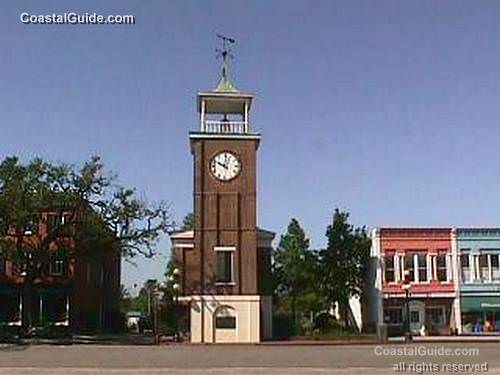
The First Locals
The earliest inhabitants of The Tidelands.. the "Native American", lived in harmony with nature. They fished from the ocean and dark water rivers, hunted game in the thick forest-land, and subsisted on the abundant berries and fruits that they could find. A nomadic people, they lived in extended family groups, with sing-song names like Pee Dee (coming and going), Wee Nee (black water or dark water people) Waccamaw, Winyah, and Santee.
The first Europeans came in 1526; under the Spanish leadership of Lucas Vesquez de Ayllon, who settled on the banks of the Winyah Bay. They failed as farmers. The Spaniards then built a vessel from the towering cypress and oak trees lining the swamp, and sailed off to the Spice Islands of the Caribbean, where there was a ready market for their slaves. They left behind their dream of gold and riches yet to be found. By the mid-1600's, English and French outposts sprang up, and trade was established with the natives. The rivers served as highways, graced with live oaks dripping with moss, and magnolias with fragrant white blossoms. Although beautiful, the swamps and rivers were alive with alligators, poisonous snakes, mosquitoes, and bordered with an impregnable growth of vines and cane. These tidelands were eventually tamed, and the native Americans were conquered. They vanished from the area, leaving behind only legends, as well as a few artifacts of pottery, arrow points and crude tools made from seashells.
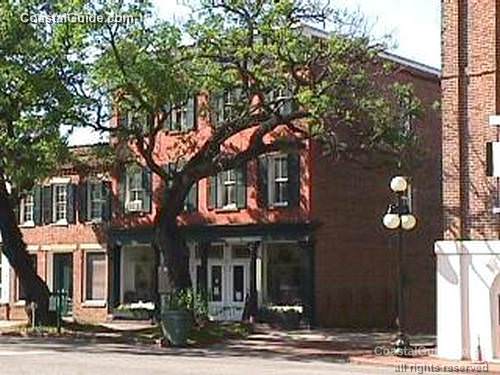
Colonization & Pirates
By 1729, Georgetown was a busy seaport, with cargo ever flowing down-river on barges and flats. Imports and exports created wealth beyond imagination. The citizens of the Georgetown District petitioned the King of England to have a port, which was officially granted in 1732 with the arrival of the King's "Collector of Customs". The slow and heavily ladened merchant ships were easy pickings for pirates, who darted out from the labyrinth of hidden bays in the barrier islands to plunder without respect for life. Some of the most famous pirates in history lurked offshore.... "Blackbeard", "Caesar", and "Red Anny", to name a few. At one point, over 2,000 pirates were flying the "Jolly Roger" up and down the coast. Blood thirsty and ruthless, most died as they had lived...violently. But what about the booty they buried and covered with human skulls and crossed bones? Some say it's still around the area, waiting to be found.
A new chapter in the history of Georgetown County was about to unfold. A grand plantation style of life that had it roots in the forbidding swamps and pineywood forests.
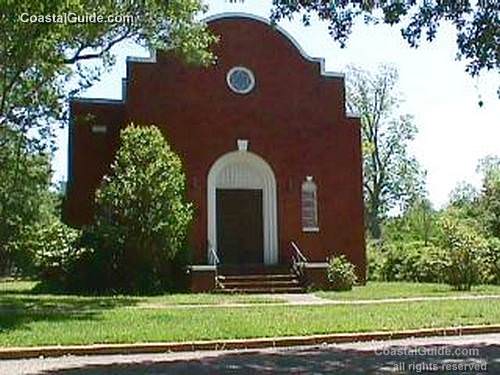
Indigo
"Naval Stores" were the primary source of local business for many years. As the full moon of change rose over the felled pines that profited pitch, turpentine, rosin and timber for shipbuilding, new and richer uses of the land were coming into existence. The "War of Jenkins Ear", a war of vanity between England and the French, Portuguese and Spanish traders left England without a source of the coveted Royal Blue Indigo dye. As the indigo plant grew wild all along the coastal plains, it was a natural transition for the cleared land to be used for cultivating indigo. Indigo is the rarest of dyes, because blue is the most difficult color to produce in a dye. Georgetown County indigo came in three colors: fine copper, purple and fine flora. Trade was brisk, and created fortunes that rivaled the wealth of the royalty of Europe. An aristocratic society of plantation owners was established, and they formed the "Winyah Indigo Society". Land was donated and a grand hall was built with rich red brick, which many year later became the home of the area's first free school. It still stands today in the city of Georgetown as a monument to our heritage.
However, by the end of the 18th century, great quantities of the dye were being produced in India and the East Indies, glutting the market. As the price fell, Georgetown planters began turning to rice cultivation, which was in worldwide demand. It was indigo, however, that gave Georgetown County its first real economic wealth, creating an aristocratic society of planters, as well as aiding in the area's ability to sever ties with England due to its financial independence.
Wild, perennial indigo plants still bloom in the spring along the roadsides of Georgetown County 200 years after the industry was abandoned.
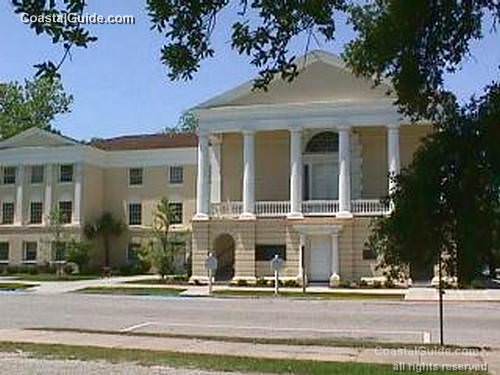
The Revolution
By the middle of the 18th century, Georgetown County was a dominant indigo and rice planting region, with a well-developed class of prominent and influential planter families. They prided themselves in being highly literate and kept up with current events. They began to resent the burden of taxation placed on their imports and exports by England. One of the area's most vocal and powerful
planters was Thomas Lynch, Jr., who was one of the original signers of the Declaration of Independence. He built his home on the banks of the Santee river, and named it Hopsewee (combining the names of the Hop and See Wee tribes)
Another area planter, Christopher Gadsden of Beneventum plantation is remembered for the flag he designed: "Don't Tread on Me!"
As the Revolutionary War began, local planter Francis Marion, the legendary "Swamp Fox", along with a ragged band of followers, almost single-handedly defeated the British in this area.
In 1791, a victorious George Washington, on his southern tour, recognized these heroes from the steps of the Masonic Lodge in Georgetown.
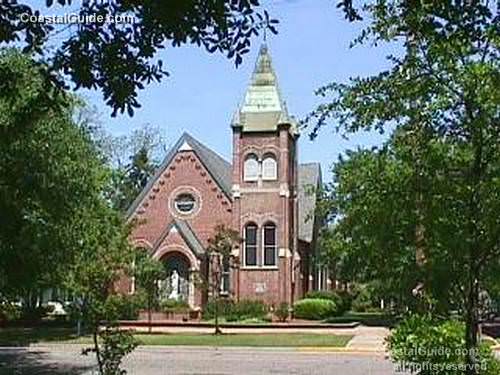
Rice
By the late 1700's , the ringing of axes must have been a constant sound through the cypress swamps. Over 40,000 acres were cleared, some 780 miles of canals were dug, and the second largest rice culture the world has ever known was established. A long golden grain called "Waccamaw Gold", sprouted in the rich, loamy soil, and ushered in perhaps the grandest, most opulent, and yet the most sorrowful chapter of Georgetown County's history. It would create an empire that would transform the area into one of the wealthiest and most influential regions in the nation.
Due to unique network of tide-controlled fresh water rivers, and rich, loamy, marshy areas, the planting of rice in this area was ideal. The original rice seeds were brought in from Madagascar to the port of Charleston around 1680. Through the years, the planting and growing of rice was experimented with and perfected, until by the 19th century, an average of 32,000,000 bushels of rice was being exported from this region, with the best year producing 56,000,000 bushels. Grocers in England praised the singular quality of "Carolina Gold" rice above all other rice. A popular book on home etiquette published in London in 1776, was adamant about "procuring only Waccamaw Gold from the Carolina", when serving rice. Rice even assumed the importance of money, being accepted as payment for taxes. For over a century a single agricultural crop sustained the economy of Georgetown.
As the county prospered, gracious living became the status quo. Elegant plantation mansions with formal tea gardens, sprawling lawns, corridors of live oak called "allees", all were hallmarks of southern aristocracy. Planter families were well-traveled and educated, they raised thoroughbred horses and drank fine European wines.
The Pawleys Island and Litchfield Beaches became in a real sense, the first resort area in America. Some say that since they were separated from the mainland by large salt marshes, malaria-bearing mosquitoes could not fly across them. Pawleys Island in particular became a favorite refuge of the wealthy planter families, some of whose homes are still standing today.
They also built lavish homes in Charleston, and stayed there during the "social season" of February, which was after the crops were harvested. All the romantic images so often associated with the "Old South" and "Gone With The Wind", grew out of the period.
Unfortunately, all this was paid for with a high human price, an accepted system of slavery. The cultivation of rice required an extraordinary amount of hard human labor, as did the upkeep of the plantation house and grounds. Some of the largest slave-holding plantations in the South were right here along the Waccamaw River, averaging between 200 to 500 slaves each. The largest plantation in the area had 1,121 slaves.
With the Emancipation Proclamation and the ending of the Civil War, slavery was abolished. For a few years, rice planters struggled to keep their industry alive, but mother nature said NO! Great storms, like the Hurricanes of 1893, 1903, 1906, 1910 and 1911 devastated the fields, and there was not the labor to rebuild. The last commercial rice harvest in Georgetown County was in 1919. The golden era of the rice empire was finally dead, giving way to reconstruction and the 20th century.
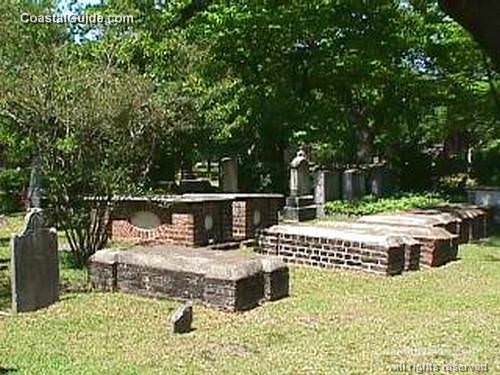
The Twentieth Century
The early part of this century saw this area flourish as a hunting preserve for the rich and powerful: from presidents and politicians, to industrialist and movie stars. Hobcaw Barony became such a retreat, created by native son Bernard Baruch, who enjoyed the visits of F.D.R., Churchill, Vanderbilt, DuPont, and others.
As the pendulum of time swung from the 19th to the 20th century, we found an untapped wealth in the forest lands that were linked to the port city and the world by the area's greatest resource-water.
It was a major undertaking to move millions of tons of rock to the two barrier islands at the entrance to the harbor and build "jetties" of over 11,000 feet on the north and 21, 000 feet on the south entrance of the bay, with steam and sail power. A dredge was built to maintain a channel and, coupled with the railway and the river system, the lumber business flourished. Mills sprang up almost overnight. The Atlantic Coast Lumber Company was the largest in the world with its 5,000,000 board foot dock and shed. Turpentine, pine rosin, shingles, furniture - but none as unusual as the DuPont wood alcohol and dynamite mill.
Over at Hobcaw Barony, the decision was made not to route the newly-conceived coastal highway down the bay and on to Charleston, but to go through the town of Georgetown. With the completion of the Lafayette Bridge, the final link from Maine to Miami put Georgetown County in the spotlight. The Intracoastal Waterway utilized the mighty Waccamaw River and Winyah Bay.
Imagine coming to the area in a coach with all your belongings and provisions for the summer, traveling a two-lane rut and having the Atlantic Ocean at your front door with a salt creek and forest out back. The pilgrimage that started with the rice planters' families to the isolated summer retreats at Pawleys Island, Litchfield and Murrells Inlet by ferrying the river or by horse and carriage could be accomplished in one day by automobile.
Coming into Murrells Inlet, the visitor found a rambling village with sections named Sunnyside, Cedar Hill and a small island called Drunken Jack's, plus a lodge or two to feed the fishermen and the few vacationing families, and a small fishing fleet. Who would have dreamed that it would grow into the Seafood Capital that it is today? Crab boys and creek boys are a thing of the past, but you can still catch your own fish and shrimp, just be careful walking in the sticky goo. Coming south at one of the largest Plantations in the world, the Huntingtons built a Morrish-style "Castle by the Sea" and developed a natural wonderland that we know as Brookgreen Gardens. With the construction of Atalaya and the road from the river to the ocean, they became the largest employer on the "Neck" in the '30s. Magnolia Beach, swept clean in the Great Storm (the hurricane of 1893) , has become a model state park with 'gators and eagles, and the castle still stands for you to view.
The Kings Highway followed the river, linking together the plantations in All Saints Parish with carriage roads down the allees of oaks to their mansions. Today, redwing blackbirds nest in the march grasses and osprey look down from their massive nests in the tops of towering cypress to survey the golf courses that meander through the old live oaks, azaleas and magnolias.
The carriage roads were paved and led you over the beach at Litchfield where the Hot & Hot Fish Club used to meet. Industries sprouted beneath the oaks from sail cordage and oak sticks. They also made hot sauce from the fields of peppers and caviar from the sturgeon from the rivers.
There was a railroad at Pawleys that ran four miles to the river and a ferry down the peaceful river to Georgetown. With the highway, there's 12 miles of uninterrupted forest and wildflowers that passes by the Hobcaw Barony, where Presidents enjoyed solitude and nature. There are 17,500 acres of forest and wetlands set aside from intrusion for all to enjoy.
The panorama from the high bridge coming into Georgetown leaves little to the imagination as to why Georgetown County is the Tidelands. Rivers flow gently to fill the blue-green Atlantic Ocean eleven miles away. Gracious townhouses and churches lie hidden in the historic district, with a shrimp boat or two, and the oldest fish-house in the state on the banks of the Sampit River.
Down the bay is Battery White, build for the defense of the port during the Civil War and surrounded by Belle Isle Plantation gardens - a national historic landmark.
In the 1930s, it was announced that the largest paper mill in the world was to be built in Georgetown and today they are responsible for the majority of our agricultural forest land, raising a renewable resource. One the banks of the Santee River where the rockfish still run, Hopsewee Plantation House still stands in all her glory with a real southern welcome for all who wish to visit.
The Georgetown Steel Mill, though a relatively recent addition, feels like it has been ingrained in the Georgetown community for as long as the town has been a hub of manufacturing along the Southeastern coastline.
The Tidelands of Georgetown County, South Carolina have hosted inhabitants for the past 50,000 years. Imagine the same beaches, swamps, salt marshes and forest land that we have today undisturbed by roadway and highrises.
East Bay Park is located on the upper portion of a small peninsula that jets out into Sampit River and Winyah Bay, and as a result, visitors will admire distant water views from virtually any part of the park.
The Rice Museum is a fascinating treasure within the Downtown Georgetown scene which is impossible to miss, and hard to forget. Detailing one of the darkest periods in American history, with a mixture of local prominent residents and maritime...



